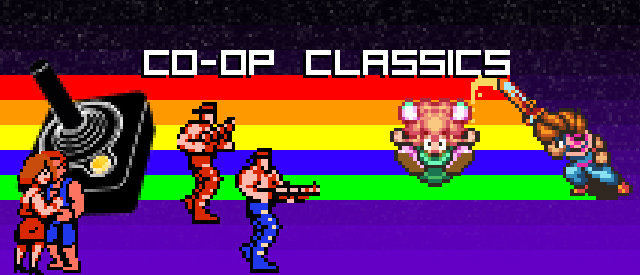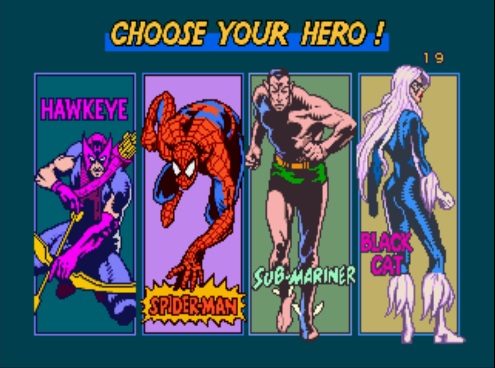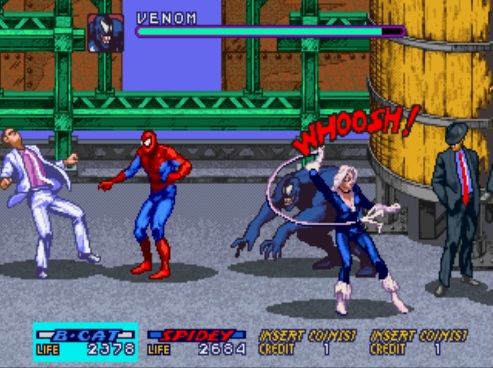

In case you've been living under a rock for the past few weeks, you are likely aware that a new Spider-Man movie is out in theaters. Spider-Man is one of the most popular characters of all time, and for good reason. He has a sweet costume, cool powers, and a wisecracking attitude; most of all, he's very human, and thus, more likeable than other heroes. The webhead's impact on popular culture is enormous, with a host of movies, cartoons, comics, and even video games under his web-cartridge-containing belt.
The past few years have given us Spider-Man games on an almost annual basis, including the recent Amazing Spider-Man movie tie in and the excellent Shattered Dimensions. Sadly, only one Spidey game in this console generation offered co-op: 2007's mediocre Friend or Foe. If we head back in time even further, we have to travel quite a ways until more co-op webslinging shows up, and one of these games is the topic of today's Co-Op Classics: Spider-Man the Video Game, which hit arcades in 1991.

In the early 90s, the brawler was the king of the arcade scene. The classics of the Golden Age, largely solo affairs, had been replaced by multiplayer offerings. Gauntlet, Golden Axe, Double Dragon, and other successful games had defined the beat em up genre. As the new decade dawned, developers applied the winning formula of these definitive games to new properties. Comic books were a natural source for inspiration, since super heroes are well known for beating up bad guys. Captain America, the Punisher, and the X-Men were just a few of the comic book licenses applied to brawlers, and Spider-Man, too, was a great fit for the genre.
Spider-Man the Video Game featured four player drop in/drop out co-op. The obvious problem in this situation is, only one person gets to play the web-slinger, so what other characters can be included to ease the sting of not controlling everyone's favorite superhero photographer? Sega's handling of the issue is mixed; Black Cat is a great inclusion, with a history of appearances in Spider-Man comics, and a similar set of powers. Hawkeye, the Avenging Archer, is a bit of a stretch. He's a great character, of course, and has an interesting set of skills that work well in a video game. But Spidey and Hawkeye didn't exactly run around much until Webhead joined the Avengers a few years back (which I would love to rant about sometime, but I digress). Still, Hawkeye makes more sense than the fourth character: Prince Namor of Atlantis, the Sub-Mariner. Sure, Namor is one of the oldest Marvel characters, but he's not exactly well known, and his power set is totally inappropriate for the game. Daredevil would have made far more sense, but I suppose three out of four isn't too bad.

Each of the characters has the standard punching and jumping moves, plus, by pressing both attack and jump together, the use of a special ability unique to the character. Spider-Man, naturally, uses his web shooters, while Black Cat uses her whip to slash enemies. Hawkeye's arrows make sense as a special attack, but Namor... Namor shoots electricity, a power he has only rarely exhibited in the comics. It's nitpicky, for sure, but just serves to underscore how odd it was to include Namor in Spider-Man the Video Game.
The standard progression in brawlers is to beat up dozens of lesser enemies, before facing a boss at the end of each level, and often in the middle of one. Spider-Man the Video Game follows this formula closely, and has the advantage of drawing from Spidey's extensive rogues gallery for bosses. The Kingpin, Venom, Dr. Doom, Electro, Scorpion, and both the Hobgoblin and the Green Goblin make appearances. It's the finest degree of fan service, for sure, though the glee at facing these villains is lessened somewhat by the sameness and boring facelessness of the street level minions that appear by the hundreds.
Spider-Man and his companions are lovingly rendered in very large sprites, though they move around a bit too slowly for super heroes. One very interesting feature of the game is the inclusion of platforming sections. The screen zooms out, reducing the heroes to a much smaller size, and the action switches from continuous fighting to jumping and light puzzle sections. It's not easy to mix genres in this way, and it's pulled off flawlessly, adding a nice variety to the action. Swapping from brawler to platformer is the best innovation the game has to offer.
If you are a fan of comic books, or just super heroes in general, you will enjoy Spider-Man the Video Game. The storyline is a bit chaotic and "kitchen-sink" in nature, but that's appropriate for both comics and 90s video games. Apart from the puzzling inclusion of Namor as a playable character (poor Daredevil never gets any love), the game is quite good. It doesn't rise to the level of X-Men, and maybe not even The Punisher, but it's definitely better than Captain America and the Avengers, despite the latter's oddball charm. The game is a solid example of the genre, and holds its own when compared to other games from the same time period. Like the character himself, Spider-Man's arcade game is a true classic.